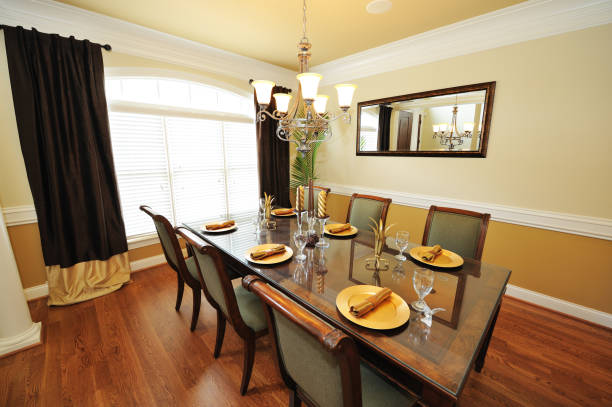The dining room is more than just a place to eat; it is the heart of connection and nourishment in your home. It’s where we gather with family and friends to share food, stories, and laughter. The way a space is arranged can genuinely influence our mood and interactions.
This is where Feng Shui comes in. It’s an ancient art of placement that helps us create environments that feel balanced and supportive. Thoughtful design choices, from the positioning of dining tables to the colours and materials used, can enhance this flow.
By blending traditional Feng Shui principles with modern practicality, anyone can create a dining room that feels both beautiful and balanced. A place where good food, good company, and good energy naturally meet.
The Heart of the Room: Table Placement and Shape
The most important principle for your dining table is placing it in the ‘command position’. Ideally, the person hosting or sitting at the head of the table should be able to see the main entrance to the room without being directly in line with the doorway. This creates a subconscious sense of safety and relaxation, allowing everyone to settle in comfortably.
If possible, avoid having anyone’s back directly facing the door. A round or oval table is excellent for promoting conversation and an easy flow of energy, with no one being left on a sharp corner. If you have a rectangular table, you can soften its energy with a fabric runner.
Wood is an excellent material as it brings a grounding, natural energy.
For harmony, have an even number of chairs.
Reflecting Good Fortune: The Art of Mirrors
Mirrors are a powerful tool in Feng Shui because they are said to double the energy of whatever they reflect. For this reason, the best place for a mirror in the dining room is where it reflects the dining table, symbolising an abundance of food and wealth for the household.
Placement is key. Be mindful of what else is in the reflection. Stay clear of mirrors that reflect clutter, harsh lighting, or doors, as this can scatter Chi or create restlessness. It’s also best to not have the mirror directly face a window or the main door, as this can bounce positive energy right back out of the room.
Ensure the mirror is large enough to reflect the entire seated group without ‘cutting off’ anyone’s head, which can be unsettling. A single, large mirror often creates a more calming effect than a collection of smaller ones. The mirror’s size should suit the wall and not overpower the room.
Choose frames in warm tones or natural finishes to enhance comfort and stability. Avoid mirrors with sharp edges or fragmented designs, as they can create visual “noise.”
A well-placed mirror brightens the room. Placement and reflection are everything—what your mirror “shows,” your home energetically receives.
Creating Clear and Easy Flow
Good Feng Shui relies on movement.
Think of energy, or Chi, as a gentle stream of water moving through your home. For it to be natural, it needs to flow smoothly and without obstruction.
In the dining room, this means creating clear pathways around the table and furniture. When walkways are blocked or too narrow, the energy can become stagnant, making the room feel heavy and stressful.
The most practical way to support this flow is to manage clutter. Keep surfaces, especially the dining table, clear when not used. A stylish sideboard or credenza is a fantastic solution for storing dinnerware, linens, and other items, keeping them accessible but out of sight.
The goal is to be able to walk around the room with ease, which in turn allows positive energy to circulate freely and create a more uplifting atmosphere.
The Vitality of Light, Colour, and Elements
Lighting and colour have a profound impact on the mood of a dining space, helping Chi circulate smoothly. A central chandelier or pendant light over the table acts as an anchor, but it shouldn't be the only light source.
Layered lighting, such as wall sconces or a lamp on a sideboard, creates a warm and inviting ambience.
Colours should reflect the room’s mood. Earthy shades like terracotta, soft beige, and warm greys are grounding and comforting. Avoid overly harsh whites or dark tones that absorb energy.
You can also balance the Five Elements for harmony. A simple way to do this is by including wood (the table, flooring), earth (ceramic dinnerware, earthy colours), metal (cutlery, frames), fire (candles, lighting), and water (in a jug or glass).
Living plants add vitality and soften hard edges, while removing spiky or thorny types prevents “sharp” energy from building up. Choose round leaves and healthy greenery, as they symbolise growth and health.
When the dining room’s light, colour, and texture all harmonise, it becomes a nurturing space that naturally supports calm and connection.
Clever Cures for Your Room
You don’t need a large, separate dining room to benefit from Feng Shui. If you live in a small home or rental, simple adjustments can make a big difference.
To define a dining area within an open-plan space, place the table and chairs on a large, oval rug. This defines the room and creates a distinct dining zone.
Portable items like mirrors on stands, plants, and table runners can all improve the look without needing permanent fixtures.
Avoid harsh overhead lighting; instead, use a floor or table lamp to create warmth.
Regularly revive the room by clearing stagnant energy—open windows before meals or light a candle for a few minutes.
These easy adjustments allow renters or anyone short on space to enjoy a calm, welcoming dining area that feels grounded, balanced, and full of positive Chi.
Ultimately, Feng Shui is more about intention than strict rules. The aim is to create a dining room that feels balanced and welcoming, encouraging connection. Use these principles as a guide to design a space that not only looks beautiful but also feels truly good to be in. Whether in a family home or a small apartment, implementing even a few of these ideas can make mealtimes more meaningful. A balanced dining room elevates both the room and those who use it.






